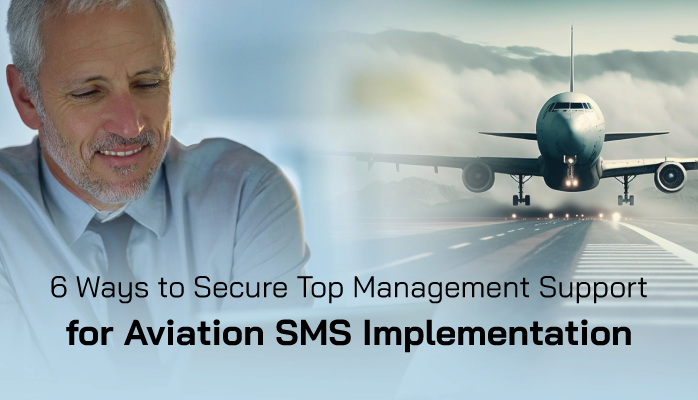Top Management Support for Aviation SMS Implementation

Securing top management support is a critical step in successfully implementing a Safety Management System (SMS) in aviation.
Without leadership buy-in, SMS initiatives often stall due to
- lack of resources,
- poor organizational alignment, or
- inadequate prioritization.
For aviation organizations—airlines, airports, or maintenance providers—SMS is not just a regulatory requirement mandated by the International Civil Aviation Organization (ICAO) but a cornerstone of operational safety and resilience. This article outlines actionable strategies to gain and sustain top management commitment for SMS implementation, ensuring a robust safety culture and regulatory compliance.
Why Top Management Support Matters for SMS
Top management sets the tone for organizational priorities. Their support for SMS ensures:
-
Resource Allocation: Funding, personnel, and tools are provided for SMS development and maintenance.
-
Cultural Influence: Leadership endorsement fosters a proactive, non-punitive safety culture.
-
Regulatory Compliance: Commitment ensures adherence to ICAO Annex 19 and national aviation authority requirements (e.g., FAA, EASA).
-
Strategic Alignment: SMS integrates seamlessly with business objectives, enhancing operational efficiency.
Without this support, SMS risks becoming a box-ticking exercise, undermining safety and exposing the organization to risks. Here’s how to secure it effectively.
Related Articles to Secure Top Management Support
- How Top Management Kills Your Aviation Safety Culture
- Advanced Aviation SMS: Top Management Support Drives SMS Profits
- How to Earn Top Management Support for Aviation SMS
1. Align SMS Benefits with Business Objectives
Executives prioritize initiatives that deliver measurable business value. To gain their support, frame SMS as a strategic asset that aligns with organizational goals like cost reduction, reputation management, and operational excellence.
How to Do It:
-
Highlight Cost Savings: Demonstrate how SMS reduces incidents, minimizing downtime, legal liabilities, and insurance costs. For example, a 2023 study by the Aviation Safety Network showed that proactive safety measures cut incident-related costs by up to 20%.
-
Emphasize Reputation: Showcase how a strong SMS enhances brand trust, appealing to customers and regulators. Cite cases like major airlines that avoided reputational damage through effective safety protocols.
-
Link to Efficiency: Explain how SMS streamlines operations by identifying inefficiencies through hazard reporting and risk assessments.
-
Use Data: Present metrics like return on investment (ROI) for SMS or case studies of competitors who benefited from robust safety systems.
2. Educate Leadership on SMS Value and Requirements

Many executives lack deep knowledge of SMS, viewing it as a technical or regulatory burden. Educating them on its purpose, benefits, and mandatory nature builds a compelling case for support.
How to Do It:
-
Simplify the Concept: Explain SMS in clear terms: a proactive system to identify, assess, and mitigate safety risks before they escalate.
-
Highlight Regulatory Mandates: Reference ICAO standards and local regulations (e.g., FAA’s Part 5 for U.S. operators) to underscore that SMS is non-negotiable.
-
Showcase Success Stories: Share examples of organizations (e.g., Qantas or Singapore Airlines) that leveraged SMS to achieve world-class safety records.
-
Offer Briefings: Organize concise workshops or presentations tailored to executives, focusing on high-level benefits rather than technical details.
3. Build a Business Case with Clear ROI
A data-driven business case is key to convincing management to invest in SMS. Executives respond to evidence of tangible returns and mitigated risks.
How to Do It:
-
Quantify Costs vs. Benefits: Estimate SMS implementation costs (e.g., software, training) against savings from reduced incidents. For instance, a mid-sized airline might spend $500,000 on SMS but save $2 million annually through fewer disruptions.
-
Highlight Risk Mitigation: Use statistics, like the FAA’s report that SMS adoption reduced runway incursions by 15% at major U.S. airports, to show risk reduction.
-
Propose Phased Implementation: Suggest a staged rollout to spread costs over time, making the investment more palatable.
-
Leverage Templates: Use free resources from regulators (e.g., EASA’s SMS toolkit) to reduce development costs and strengthen the case.
Related Articles to Secure Top Management Support
- Advanced Aviation SMS: Top Management Support Drives SMS Profits
- Advanced Aviation SMS: Avoid Leaving Money Behind
- Advanced Aviation SMS: Rewriting Duties to Align with Business Goals
4. Engage Leadership in SMS Development
Involving top management in SMS planning fosters ownership and demonstrates its strategic importance. Passive approval is less effective than active participation.
How to Do It:
-
Form a Steering Committee: Invite executives to join an SMS oversight group, giving them a direct role in shaping safety policies.
-
Solicit Input: Ask for their perspectives on safety priorities, aligning SMS with their vision for the organization.
-
Showcase Quick Wins: Implement small, visible SMS components (e.g., a hazard reporting app) early to demonstrate immediate value and build momentum.
-
Regular Updates: Provide concise progress reports to keep leadership informed and engaged without overwhelming them.
5. Foster a Safety Culture Through Leadership Example
Executives’ behavior shapes organizational culture. Their visible commitment to SMS encourages employees to embrace safety practices, reinforcing the system’s effectiveness.
How to Do It:
-
Lead by Example: Encourage executives to participate in safety briefings, submit hazard reports, or attend SMS training alongside staff.
-
Communicate Commitment: Have leadership issue public statements or internal memos emphasizing SMS as a core value. Update and publish the CEO's Commitment to Safety annually or semi-annually.
-
Recognize Contributions: Promote a non-punitive culture by rewarding employees who report hazards, with executives personally acknowledging top contributors.
-
Integrate Safety in Strategy: Ensure SMS is a standing agenda item in board meetings, signaling its priority.
6. Leverage External Expertise and Partnerships

If internal expertise or resources are limited, external support can bolster the case for SMS and reassure management of its feasibility.
How to Do It:
-
Hire Consultants: Engage aviation SMS specialists to guide implementation, providing credibility and reducing risks.
-
Partner with Industry Groups: Collaborate with organizations like IATA or Flight Safety Foundation to access best practices and training.
-
Use Technology: Invest in user-friendly SMS software (e.g., SMS Pro) to streamline processes, demonstrating efficiency to executives.
-
Benchmark Competitors: Show how industry leaders use SMS to gain a competitive edge, pressuring management to keep pace.
Related Aviation Safety Articles
- Independent Aviation SMS Consulting - Pros and Cons
- 9 Success Tips for Aviation SMS Consultants
- How to Reduce Complexity of Aviation SMS Implementations
Conclusion
Securing top management support for aviation SMS implementation is a strategic effort that requires
- aligning safety with business goals,
- educating leaders,
- building a compelling business case,
- engaging executives,
- fostering a safety culture, and
- leveraging external expertise.
By presenting SMS as a value-driven, mandatory, and achievable initiative, aviation organizations can gain the leadership commitment needed to build a robust Safety Management System. This not only ensures compliance with ICAO and national regulations but also enhances safety, efficiency, and reputation—delivering benefits that resonate with executives and stakeholders alike.
Start today by crafting a tailored pitch to your leadership team and watch SMS transform your organization’s safety landscape. If you need user-friendly software tools, don't forget to review SMS Pro.






